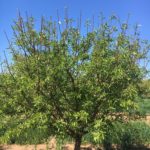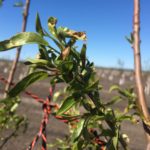Spring conditions over the past week have finally turned favorable for growth. After a very warm winter, a long bloom with periods of cold weather, followed by a few weeks of wet weather, trees are starting to grow and nuts are beginning to size. These weather conditions have led to a few interesting observations and considerations for the spring.

- Leaf lesions caused by bacteria. Observations from several fields have yielded the occurrence of bacterial leaf spots. These spots are thought to be caused by Pseudomonas syringae, the same bacteria that causes blossom blast. Lesions are often varied in shape and have a distinctive yellow halo. Generally, the tree recovers after shedding a few leaves. Conditions can worsen if rains persist. Copper treatments to prevent may do more harm than good due to tree sensitivity. Lesions can be easily confused with herbicide drift or shot-hole; review application history to determine if these could be potential causes.
- Vegetative bud failure. Just as we observed in 2015, we have been observing vegetative buds within last year’s growth failing to push. This “bud failure” is not the same as non-infectious bud failure (crazy top) as future generations of buds will be healthy. Although we are unsure of exactly why this type of bud failure occurs, we believe it to be due to a reduction of localized carbohydrates from the December and January temperature ranges. Explained simply, warm winter days and nights below freezing increase the rate of respiration, leading to reduced carbohydrates to assist with bud break. If levels drop too low, buds can die. Often, healthy buds below the affected area will grow and hide the damage that occurred. Sometimes, buds will break later than normal.
- More rain. Mid-range forecasts are predicting rain for the end of the first week of April. These rains appear to be coming off the tropics and will be warm. Being a multi-day event, a fungicide application may be necessary. If a spray has not been made within the last 7-10 days, consider making a spray with a rotating chemistry to reduce the occurrence the spring time diseases of Anthracnose, Scab and Shot-hole. If a history of bacterial spot, a copper-manzate application should be considered.
- First irrigation timing. Water usage through spring Is low due to plant stage, temperatures and day length. Soil moisture levels and plant water status should be monitored to determine when to apply the first irrigation. Irrigating too soon can lead to reduced growth and yield due to loss of fine feeder roots as well as root disease. If needing to fertilize and making an application by ground is not possible, apply the fertilizer in as short of a set as possible.
- Maximum Residue Limits on Phosphonate products increased. The EU has increased the maximum MRL level for Phosponate/Phosphite within almonds (500 ppm). Applications should be considered within orchards having a history of Phytophthora disease. Work within walnuts has shown that foliar applications are more effective than applications made through the irrigation water. Generally, 1-2 quarts/acre of a high phosphite containing product will provide 6 months or greater control. If considering product application, the spring timing should be made after full leaf expansion with the second application in the post-harvest. More can be found on the UC IPM webpage.



Hadi
April 22, 2021What can be done to cure bud failure?
David Doll
April 25, 2021Dear Hadi,
Non-infectious bud failure, which is common in ‘Carmel’ is a genetic disorder and it has no cure. Pruning the dead material out will make the tree look better in the short term, but the look will return in 2-3 years.
Time-to-time, environmental conditions cause vegetative bud failure which is due to the vegetative buds being depleted of energy, and failing to push. In this case, it is best to just let the tree recover. Within a few years, the old symptoms will not be noticeable.
David